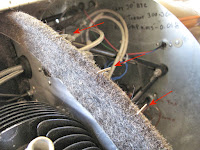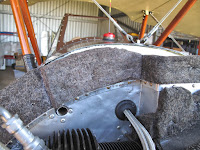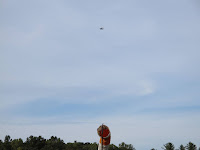One of my tasks after the test flight was to re-inspect the plane and particularly the motor to make sure nothing is loose, leaking, etc. as well as making sure once again that everything is properly safetied. I haven't found any problems, which is good.
Before taking the cowl off I had a bright idea, I should have had ages ago, to put a light behind the main cooling air baffle so I could see if there were any air leaks. It turns out the cowl doors do not seat against the felt seal on the baffle.
That sliver of a gap is about 3/8" wide in the middle and 12" long. I have ideas for fixing it. We'll get back to it in another post.
With the cowl off and the top spark plugs out for safety, I checked the mag. switch wiring with an Ohm meter, but couldn't find a problem.
I decided to remove the mag. switch to see if it was malfunctioning. Fortunately it's serviceable. By removing the 2 screws you can remove the back plate.
The fixed contacts look real good and still have grease to prevent corrosion.
The movable contacts bridge from the center, ground, to the outer, magneto, contacts. They're in good condition also.
The movable contacts are held in place by the springs, which are the same length with no broken coils.
There are detent bumps on the moveable plate, attached to the key tumbler, which hold the switch in each position.
The detent spring is OK and works well.
Overall the switch is not the problem. I've reassembled and reinstalled it.
Before hooking up the switch I used the magneto timing light to make sure there isn't an open in the magneto's internal wiring by rechecking the point timing. No problem there.
While reconnecting the switch wiring to the magnetos I found the problem. The wire on the left magneto had broken at the screw terminal. I had put a piece of heat shrink tubing over the wire and the end of the terminal as a strain relief. The idea was to stop motor vibration from wiggling and breaking the wire at the end of the terminal. That was a good plan but, with all the removing and reinstalling of the magnetos I wiggled and broke the wire. Trapped under the heat shrink tubing it wasn't obvious it was broke. while holding the meter probe to it for good contact the broken wire made contact, hiding the problem. I've installed a new terminal, without the tubing.
We'll find out for sure I've solved the problem once I've finished with the baffle leak. Until then I'll treat it as a hot engine, top plugs out when working around it.








































